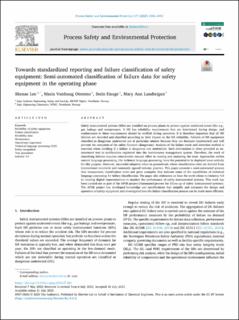| dc.contributor.author | Lee, Shenae | |
| dc.contributor.author | Ottermo, Maria Vatshaug | |
| dc.contributor.author | Hauge, Stein | |
| dc.contributor.author | Lundteigen, Mary Ann | |
| dc.date.accessioned | 2024-01-09T10:05:40Z | |
| dc.date.available | 2024-01-09T10:05:40Z | |
| dc.date.created | 2023-08-08T13:58:16Z | |
| dc.date.issued | 2023 | |
| dc.identifier.citation | Process Safety and Environmental Protection (PSEP). 2023, 177 1485-1493. | en_US |
| dc.identifier.issn | 0957-5820 | |
| dc.identifier.uri | https://hdl.handle.net/11250/3110548 | |
| dc.description.abstract | Safety instrumented systems (SISs) are installed on process plants to protect against undesired events like e.g., gas leakage and overpressure. A SIS has reliability requirements that are determined during design, and conformance to these requirements should be verified during operation. It is therefore important that all SIS failures are recorded and classified according to their impact on the SIS reliability. Failures of SIS equipment classified as dangerous undetected are of particular interest because they are dormant (undetected) and will prevent the execution of the safety function (dangerous). Analysis of the failure mode and detection method is essential when deciding if a failure is dangerous and undetected. Such information is often provided as unstructured text in notifications registered into the maintenance management system. Therefore, the work of classifying failures requires considerable manual effort in reading and analyzing the texts. Approaches within natural language processing, like technical language processing, have the potential to be deployed more actively for this purpose. However, successful adoption relies on groundwork where classification rules are derived from international standards and commonly agreed industry practice. This paper presents a semi-automated process that incorporates classification rules and gives examples that indicate some of the capabilities of technical language processing for failure classification. The paper also elaborates on how the work relates to Industry 4.0 in creating digital representations to monitor the performance of safety instrumented systems. This work has been carried out as part of the APOS project (Automated process for follow-up of safety instrumented systems). The APOS project has developed knowledge and specifications that simplify and automate the design and operation of safety equipment and investigated how the failure classification process can be made more efficient. | en_US |
| dc.language.iso | eng | en_US |
| dc.publisher | Elsevier | en_US |
| dc.relation.uri | https://doi.org/10.1016/j.psep.2023.07.061 | |
| dc.rights | Navngivelse 4.0 Internasjonal | * |
| dc.rights.uri | http://creativecommons.org/licenses/by/4.0/deed.no | * |
| dc.title | Towards standardized reporting and failure classification of safety equipment: Semi-automated classification of failure data for safety equipment in the operating phase | en_US |
| dc.title.alternative | Towards standardized reporting and failure classification of safety equipment: Semi-automated classification of failure data for safety equipment in the operating phase | en_US |
| dc.type | Peer reviewed | en_US |
| dc.type | Journal article | en_US |
| dc.description.version | publishedVersion | en_US |
| dc.source.pagenumber | 1485-1493 | en_US |
| dc.source.volume | 177 | en_US |
| dc.source.journal | Process Safety and Environmental Protection (PSEP) | en_US |
| dc.identifier.doi | 10.1016/j.psep.2023.07.061 | |
| dc.identifier.cristin | 2165628 | |
| dc.relation.project | Norges forskningsråd: 295902 | en_US |
| cristin.ispublished | true | |
| cristin.fulltext | postprint | |
| cristin.qualitycode | 1 | |

